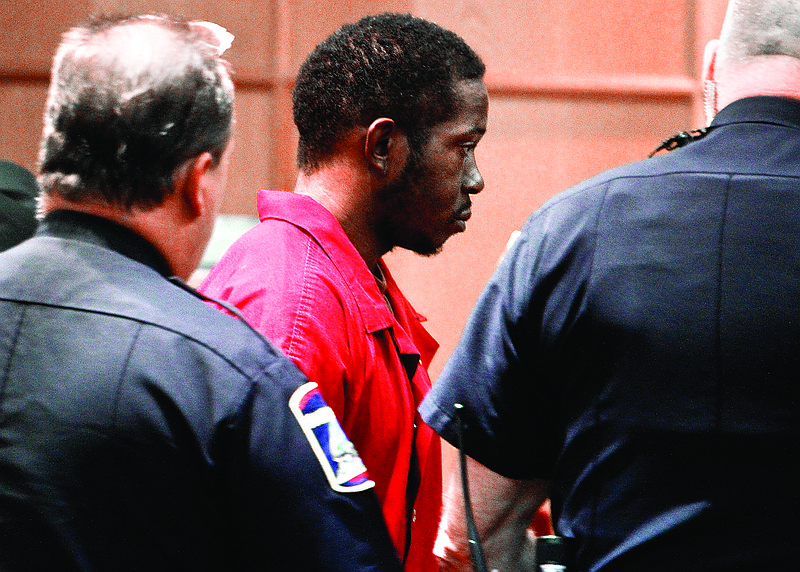Three-year-old Tatiana Emerson once played dead to escape abuse by her mother's boyfriend, her brother told investigators after she was beaten to death in August 2014.
TrayVon Emerson, 5, told investigators from the Tennessee Department of Children's Services that Rhasean Lowry, 36, beat him and Tatiana with a belt, punched him in the face and stomach and would make him and his sister squat against the wall until their legs shook - then punish them if they fell over.
Once, he said, Lowry threw Tatiana on a bed and she bounced to the floor and played dead.
A newly released investigation report from the Department of Children's Services details the extent of the abuse Tatiana and TrayVon suffered and reveals that agency workers visited the family four times on allegations of abuse and neglect before Tatiana's death - but they left each time without taking any action.
DCS workers last checked on the family and concluded all was well a month before Tatiana died on Aug. 27, 2014. Two days after she died, another local 3-year-old, Dakota Arndt, also died from chronic abuse - and DCS workers also had checked on that family before his death.
In both cases, a system designed to save children like Dakota and Tatiana failed - and that's common.
In 2014, most Tennessee children who were not in DCS custody but died among allegations of neglect or abuse had a relevant history with the agency in the three years before their deaths.
An internal DCS review of 133 child death cases in 2014 revealed that 117 children - 88 percent - had history with DCS.
Nationally, between 40 percent and 50 percent of children who die at the hands of their caregivers have a previous report on file with child protective services, said David Finkelhor, director of the Crimes Against Children Research Center.
"In a way that's both good news and bad news," he said. "The good news is a lot of these families are known to some degree, therefore if we could somehow refine our abilities and increase the resources we have to offer those families, maybe we could protect those children better. But the bad news is it shows it is a very serious challenge."
***
Tatiana didn't have a heartbeat when Lowry brought her to a Chattanooga hospital on Aug. 26, 2014, the DCS report says. Lowry claimed she'd fallen downstairs at the hotel where the family was living. Her mother and brother were not there at the time.
But hospital staff and police quickly determined that Tatiana's injuries could not have been from a fall. Surveillance video from the hotel showed Lowry loading the child's limp body into his car and then stopping to pay for another night at the hotel before he left for the hospital.
Hospital staff couldn't say how long she'd been without a heartbeat when Lowry brought her in. They revived her, but she died a day later.
Lowry was charged with felony murder, aggravated child abuse, rape of a child and making false reports. Hamilton County Medical Examiner James Metcalfe concluded in an autopsy that Tatiana was raped before she died and had suffered chronic, long-term injuries.
In March, Tatiana's mother, Melanie Emerson, 22, was charged with aggravated child endangerment. The DCS report concludes that Emerson knew about Lowry's abuse and failed to protect her children. That's based in part on TrayVon's statements to investigators that he was afraid of his mother.
Both Lowry and Emerson are scheduled to appear in Hamilton County Criminal Court on Monday.
Tatiana's case is remarkably similar to that of Dakota Arndt.
Dakota's mother, Brianna Kwekel, was away when her boyfriend allegedly beat Dakota to death in their home.
Justin Bradley was charged with criminal homicide. He later committed suicide in the Hamilton County Jail. And, just like Melanie Emerson, Dakota's mother was later charged with aggravated child endangerment. She's scheduled to appear in Criminal Court on Nov. 12.
Dakota was checked out by an investigator with the Department of Children's Services when he was treated for swollen testicles at Erlanger on June 17, 2014, but still went home with his mother that night.
Tatiana was last visited by DCS on July 24, 2014, with the worker investigating a complaint about insufficient supervision.
Dakota died 74 days after DCS' last visit. Tatiana's death came 35 days DCS was there.
***
Child protective caseworkers walk a thin tightrope when they investigate allegations of child abuse, Finkelhor said.
The stakes are high: Pulling a child from a home when there is no need is traumatic for the child and the parents, and it burdens an already-crowded child welfare system. On the other hand, failing to pull a child who is in danger can end in the child's injury or death.
"They're operating in a highly politicized environment with people close to the child-protection system feeling like child-protective services isn't aggressive enough when substantiating abuse, but others feeling they are way too aggressive," Finkelhor said.
Caseworkers look for evidence of physical injuries - scratches, bruises - but also ask the child questions about their parents and living situation, said Chattanooga resident Jane Elmore, who retired from the Illinois Department of Children and Family Services. Caseworkers note environmental factors, consider how children interact with their parents and look for inconsistencies in the caretakers' stories.
Sometimes, even visible injuries are not enough to substantiate abuse, Finkelhor said.
"There are some kinds of injuries that are very indisputably inflicted injuries - certain kinds of fractures - but there are other kinds of injuries that could have happened accidentally and if the family is saying, 'Oh, she fell out of her crib,' it can be hard to dispute."
Only about 25 percent of allegations of abuse are substantiated nationwide, Finkelhor said. Of those cases, only about a fifth of the children are immediately removed from the home.
Dakota's and Tatiana's young ages likely made interviewing them difficult, Elmore and Finkelhor said.
"In DCS' defense, no one has a crystal ball," Elmore said. "Hindsight is 20-20. And so it could be that the best caseworker in the world is making their best judgment. On the other hand, there are sometimes caseworkers who aren't very good or very committed or God forbid, just don't care."
Rob Johnson, spokesman for Tennessee's DCS, declined to provide any case-specific information about Tatiana's case, citing the ongoing criminal prosecution. He declined to say whether the same case manager checked on Tatiana's family in all four allegations of abuse, and he could not say how experienced that case manager was.
Johnson did say that DCS investigators undergo annual training and complete a Tennessee Bureau of Investigation Academy that is designed specifically for child-abuse investigations.
DCS also published an internal review of the deaths and near-deaths the agency handled in 2014. DCS safety analysts conducted 348 interviews with front-line workers who were involved in child death cases in 2014, the review states, and identified three "areas of improvement."
Those interviews revealed that DCS employees did not have enough information about complex medical issues to handle some cases and were not aware of all the available resources to help; that workers did not consistently run background checks on all adults in a household when investigating allegations of abuse and sometimes limited those background checks to one county; and that workers had a hard time obtaining medical records for children as they investigated allegations of abuse.
The report - the second Child Death Review published by DCS - suggested several training actions to address the identified problems.
"The [Child Death Review] process exists to best explain the inherently complex nature of child welfare work and the many factors which influence decision-making," the report states.
"These decisions alone are rarely direct causal factors in a child's death or near death; but, these decisions may affect the overall trajectory of well-being for a child or family and be an influence, among many influences, of poor outcomes."
Contact staff writer Shelly Bradbury at 423-757-6525 or sbradbury@timesfreepress.com with tips or story ideas.

